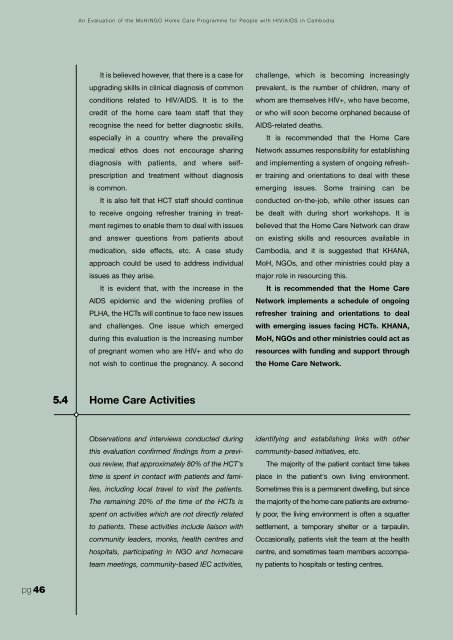PDF File - hivpolicy.org
PDF File - hivpolicy.org
PDF File - hivpolicy.org
- No tags were found...
You also want an ePaper? Increase the reach of your titles
YUMPU automatically turns print PDFs into web optimized ePapers that Google loves.
An Evaluation of the MoH/NGO Home Care Programme for People with HIV/AIDS in CambodiaIt is believed however, that there is a case forupgrading skills in clinical diagnosis of commonconditions related to HIV/AIDS. It is to thecredit of the home care team staff that theyrecognise the need for better diagnostic skills,especially in a country where the prevailingmedical ethos does not encourage sharingdiagnosis with patients, and where selfprescriptionand treatment without diagnosisis common.It is also felt that HCT staff should continueto receive ongoing refresher training in treatmentregimes to enable them to deal with issuesand answer questions from patients aboutmedication, side effects, etc. A case studyapproach could be used to address individualissues as they arise.It is evident that, with the increase in theAIDS epidemic and the widening profiles ofPLHA, the HCTs will continue to face new issuesand challenges. One issue which emergedduring this evaluation is the increasing numberof pregnant women who are HIV+ and who donot wish to continue the pregnancy. A secondchallenge, which is becoming increasinglyprevalent, is the number of children, many ofwhom are themselves HIV+, who have become,or who will soon become orphaned because ofAIDS-related deaths.It is recommended that the Home CareNetwork assumes responsibility for establishingand implementing a system of ongoing refreshertraining and orientations to deal with theseemerging issues. Some training can beconducted on-the-job, while other issues canbe dealt with during short workshops. It isbelieved that the Home Care Network can drawon existing skills and resources available inCambodia, and it is suggested that KHANA,MoH, NGOs, and other ministries could play amajor role in resourcing this.It is recommended that the Home CareNetwork implements a schedule of ongoingrefresher training and orientations to dealwith emerging issues facing HCTs. KHANA,MoH, NGOs and other ministries could act asresources with funding and support throughthe Home Care Network.5.4 Home Care ActivitiesObservations and interviews conducted duringthis evaluation confirmed findings from a previousreview, that approximately 80% of the HCT'stime is spent in contact with patients and families,including local travel to visit the patients.The remaining 20% of the time of the HCTs isspent on activities which are not directly relatedto patients. These activities include liaison withcommunity leaders, monks, health centres andhospitals, participating in NGO and homecareteam meetings, community-based IEC activities,identifying and establishing links with othercommunity-based initiatives, etc.The majority of the patient contact time takesplace in the patient's own living environment.Sometimes this is a permanent dwelling, but sincethe majority of the home care patients are extremelypoor, the living environment is often a squattersettlement, a temporary shelter or a tarpaulin.Occasionally, patients visit the team at the healthcentre, and sometimes team members accompanypatients to hospitals or testing centres.pg 46
















